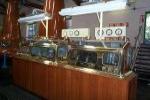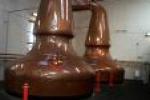|
Remark : |
Only Blending or endependent vintage. A component of the Johnnie Walker blends.
They use ex-bourbon casks
The Dailuaine (Dale-yoo-in) distillery have 3 wash stills and 3 spirit stills.
From The Dailuaine distillery folder:
For more than 100 years distillery "pluggies" puffed through the Highland daily, talking supplies of barley and coal to the distilleries and returning loaded with casks of whisky.
At DAILUAINE an engine driver, fireman and railwayman were employed full-time to run the much-loved steam locomotive whose gleaming paintwork and polished brass and copper made her a "joy to behold".
The engine was one of the last to run and is now being restored by United Distillers.
William Mackenzie, a farmer at Carron and Rinnachat, founded the distillery in 1851 in hollow by the Carron Burn and named it from the Gaelic for "the green vale".
By 1863, the arrival of the Strathspey Railway at Carron, only some three miles away, opened up the outside world and influenced the long-term future of Dailuaine Distilllery which was eventually to be linked by its own siding into the network of the "whisky railway" of the Highlands.
When Mackenzie died in 1865 the distillery was let until 1879 when his son, Thomas Mackenzie, became a partner in the business and set out to rebuild Dailuaine in a larger and more modern style and, with an annual output of 160,000 gallons, making it one of the largest Highland distilleries.
In 1891, Mackenzie & Co was converted into a limited liability company, The Dailuaine-Glenlivet Distillery Ltd which seven years later amalgamated with The Talisker Distillery Ltd, Skye, to form Dailuaine-Talisker Distilleries Ltd.
Thomas Mackenzie, who had a substantial interest in the Talisker Distillery, became chairman and managing director of the new company, which also owned a grain whisky distillery in Aberdeen and Imperial Distillery, which Mackenzie had built on the Speyside railway at Carron Station.
By 1907 railway sidings linked Dailuaine with Imperial and Carron warehouses. Mackenzie was an ambitious entrepreneur who strove to develop the company's business in whisky blending as well as distilling, setting up agencies for their brands at home and abroad.
Not long afterwards the whisky industry was affected by a recession and in 1910 the company traded at a loss and went on to suffer a series of misfortunes, with heavily reduced demand, lawsuits and the destruction of the Aberdeen distillery by fire.
When Mackenzie died in 1915, a widower with no family, the business was bought by a consortium of customers, including James Buchanan & Co. Ltd, John Dewar & Sons Ltd and John Walker and Sons Ltd, all part of United Distillers.
Dailuaine was substantially rebuilt after a fire in 1917 which caused extensive damage and production resumed in 1920 after which, for the next 40 years, Dailuaine relied on diverse and ingenious sources of power for lighting and for driving the machinery.
Four steam engines were employed and two water wheels gave an alternative source of power for the maltings. These water wheels worked in tandem; one was sited next to the main engine so that it could be connected during a drought or other emergency, and the other was about 200 metres away, by the burn - the two were coupled by a continuous wire rope supported on overlead pulleys.
Dailuaine was connected to the national electric grid in 1950 and a major reconstruction took place in 1959-60. The stillhouse, which had been increased from four to six stills was modernised in 1965; a new mash tun was installed in 1993.
Two years later the Strathspey railway closed and the much-loved puggies ceased to run. An 0-4-0 saddletank locomotive, made by Barclay of Kilmarnock in 1897, had worked the line until 1939, when it was replaced by another Barclay engine, Dailuaine No. I, which a retired British Rail engine driver described as "truly a joy to behold", with well-cleaned paintwork and polished brass and copper.
Distillery employees gave Dailuaine's puggy its last unofficial run in 1970 when it was removed to the Strathspey Railway Association steam railway at Boat of Garten, Inverness-shire. However, No. I has now been returned to United Distillers and is being restored for display at Aberfeldy Distillery.
Today Dailuaine can be enjoyed as a single malt available at the distillery and selected outlets in bottles featuring the distillery symbol of a badger, a species associated with the surrounding area.
-
Source www.bbr.com :
Dailuaine Distillery, Speyside
Between the mountain Ben Rinnes and the river Spey at the hamlet of Carron, not far from Aberlour, lies the Dailuaine (pronounced: dale-you-an) distillery. It was built in 1852 by William Mackenzie.
After William died, a banker from Aberlour, James Fleming, leased the distillery until 1879, when his son, Thomas, formed 'Mackenzie & Company' together with James Fleming. Dailuaine pioneered the 'pagoda' roof design, conceived by Charles Doig. Many distilleries, such as Aberlour and Ardbeg followed suit.
Between 1884 and 1887 Dailuaine was rebuilt and expanded, becoming one of the largest distilleries in the Highlands at the time. Major alterations took place in 1960, with the addition of stills (six in total) and the replacement of floor maltings by a so-called 'Saladin Box'. The device (named after its inventor Charles Saladin) is a big, flat box which mechanically turns the germinating barley inside and allows air to pass through it. The Saladin was closed in 1983 when the distillery started to purchase its malt from one of the large 'industrial' maltings. Just like so many other distilleries in Scotland, Dailuaine was eventually absorbed by industry giant Diageo in 1998.
Only 2% of the production is marketed as single malt (sold by Diageo in the Fauna & Flora collection or by independent bottlers), the remaining part is destined for blends like Johnnie Walker. Dailuaine single malt is a robust, full-bodied, rich, after-dinner malt.
|



